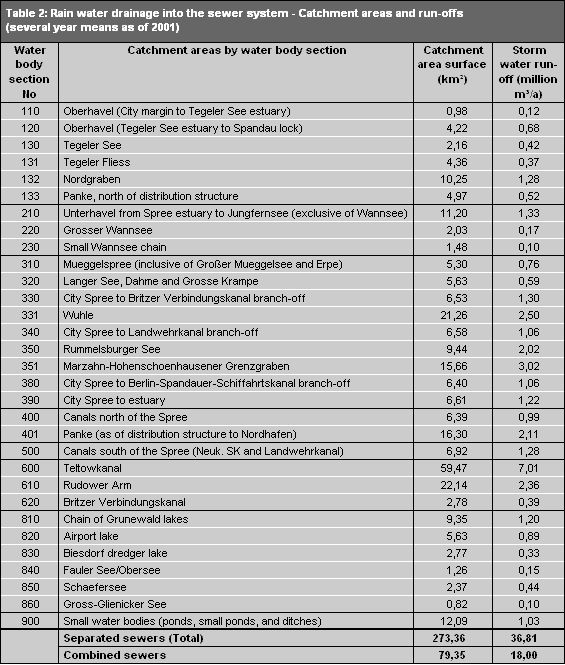The inner city districts of Wedding, Tiergarten, Mitte, Prenzlauer Berg, Friedrichshain, Kreuzberg, Schoeneberg, parts of Neukoelln, and of Wilmersdorf, Westend, as well as Spandauer Altstadt are connected to the combined sewerage system.
The outlying districts of Reinickendorf, Pankow, Weissensee, Hohenschoenhausen, Marzahn, Hellersdorf, Lichtenberg, Koepenick, Neukoelln, Tempelhof, Steglitz, Zehlendorf, Spandau as well as parts of Wilmersdorf and Charlottenburg are connected to the separate sewerage system.
In Berlin rain water sewers cum foul water drains represent the prevalent type of separate sewerage system. Districts with this type of system are mainly found in closer proximity to the inner city areas. These districts cover Spandau, Reinickendorf, Pankow, Lichtenberg, Marzahn-Hellersdorf, Treptow-Koepenick, Neukoelln, Tempelhof-Schoeneberg and Steglitz-Zehlendorf, as well as some south-western sections of Wilmersdorf-Charlottenburg, a small area in the north-eastern part of Mitte as well as the Stralau peninsula in the south-eastern section of Friedrichshain.
A few city areas where rain water drains were provided without foul water drains are situated in the eastern parts of the city such as Blankenburg, Biesdorf-Sued, Kaulsdorf, Mahlsdorf, Koepenick-Nord and Bohnsdorf.
To reduce the load on combined sewers, some areas to the north of the municipal motorway rain water sewers were built which discharge into the rain overflow drains of the combined sewerage system. Sewage continues to pass through these combined sewers. This also holds true of the city area of Weissensee and sections of Schlossstraße in Charlottenburg, north of Bismarckstrasse.
Since 1990 sewerage connections were provided for the city areas of Weststaaken and Kladow as well as parts of Reinickendorf (areas on the western margins), Karow, parts of Buchholz-West II, Weststaaken, Kladow, Weissensee Altsiedlung, Stadtrandsiedlung Malchow, Stadtrandsiedlung Buch, Biesdorf Nord, Kaulsdorf Nord, parts of Kaulsdorf Sued, parts of Mahlsdorf Nord, parts of Mahlsdorf Sued, parts of Dammfeld West, parts of Rahnsdorf, Mueggelheim Nord, Johannistal, Dankmarsteig, parts of Bohnsdorf and Schmoeckwitz as well as of Reinickendorf (areas on the western margins), Weissensee, Koepenick and Marzahn.
Those areas of Berlin which do not have any sewerage systems or which are only partly connected and for which plans exist to provide connections so that they will at least have foul water drains by the end of 2005 are the following: Buchholz Altsiedlung, parts of Karow Altsiedlung, Hohenschoenhausen Altsiedlung, Wartenberg Altsiedlung, Falkenberg Altsiedlung, Gehrensee, Gartenstadt Hohenschoenhausen, Biesdorf Nord, the remaining part of Kaulsdorf Sued, parts of Mahlsdorf Nord III, Mahlsdorf Sued, Stadtrandsiedlung Biesdorf Sued, Kaulsdorf Sued, Biesdorf Sued, Elsengrund, Hirschgarten, Siedlung Spaethsfelde, Johannistal Sued, Siedlung Weiss, Gruenau Nord, Altglienicke Sued, Falkenberg, Falkenhorst, the remaining part of Gruenbergallee, Bohnsdorf West, Bohnsdorf Nord, Mueggelheim Sued, Rahnsdorfer Muehle West, Rahnsdorf Nord, Hessenwinkel, Weststaaken – Fahrlander Weg and Weststaaken – Zeestower Weg.
Parts of Berlin which have foul water drains but leave stormwater to percolate into the ground are to be found mainly in surburban areas, such as in Gatow, Spandau, Konradshoehe, Heiligensee, Frohnau, and in a few other parts of the outlying city areas.
02.09.2 Catchment areas of rain water canalisation
Depending on the main receiving water body, the catchment areas of stormwater sewers are found in the running water section of the Spree and Dahme rivers in the eastern and southeastern sections of Berlin, in the running section of the Havel river in the northern, northwestern and southwestern parts of Berlin as well as in the running section of the Teltowkanal in southern Berlin.
Lakes which are a part of the landscape and of parks, as well as ponds and other blind drainage water bodies are spread over the entire city area.
As a combined system prevails within the inner S-Bahn circle line and this area mostly does not have any separate sewers, this part of the city was not allocated to any stormwater sewerage catchment area. The only exceptions are Tempelhof airport and parts of Wilmersdorf to the north of the motorway, draining into the canals south of the Spree river (Neukoellner Schifffahrtskanal and Landwehrkanal).


